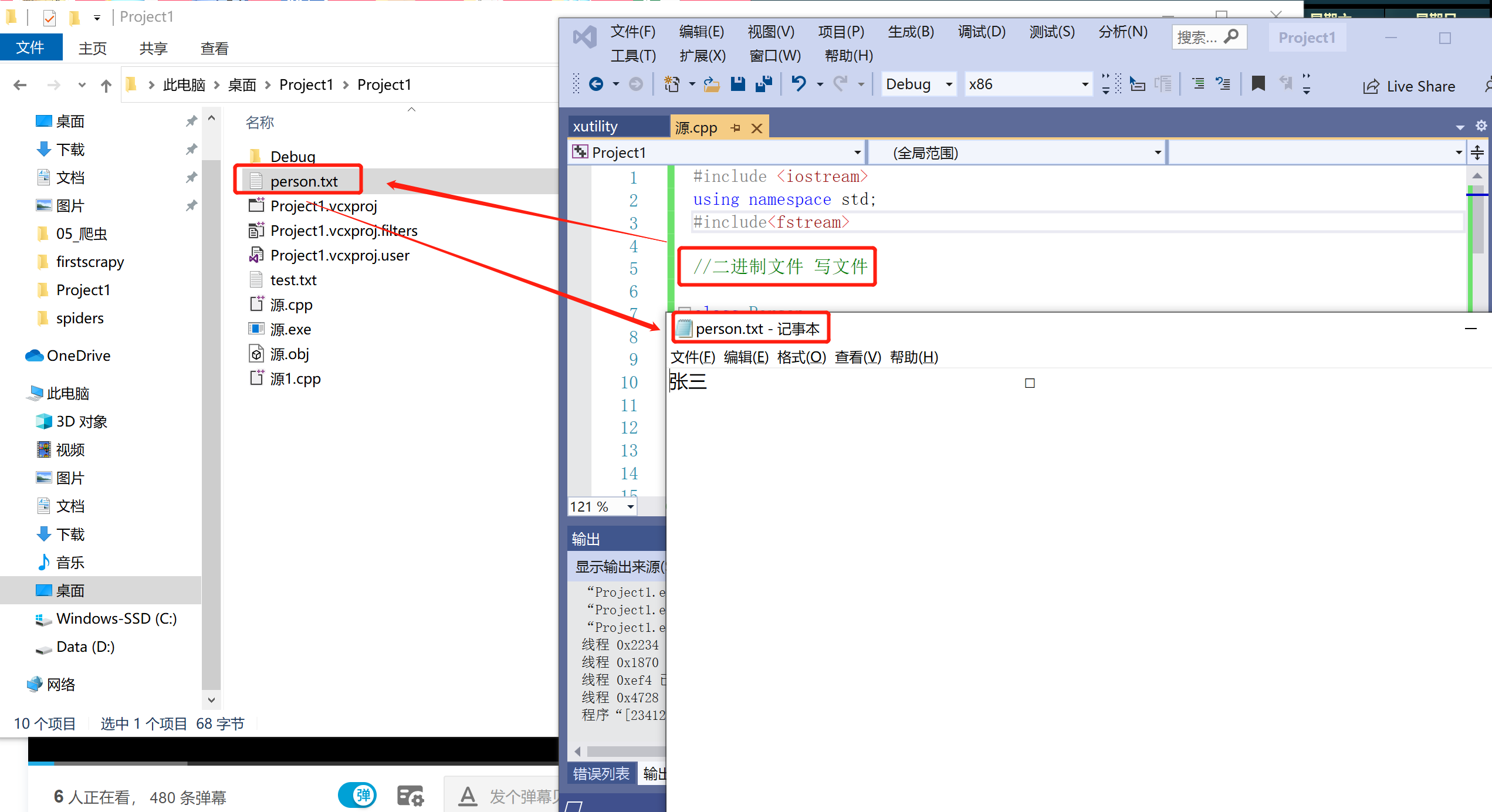C++的文件操作
1. 文件操作简介
① 程序运行时产生的数据都属于临时数据,程序一旦运行结束都会被释放。
② 通过文件可以将数据持久化。
③ C++中对文件操作需要包含头文件<fstream>
④ 文件类型分为两种:
- 文本文件:文件以文本的ASCII码形式存储在计算机中。
- 二进制文件:文件以文本的二进制形式存储在计算机中,用户一般不能直接读懂它们。
⑤ 操作文件的三大类
- ofstream:写操作
- ifstream:读操作
- fstream:读写操作
⑥ 文件打开方式可以配合使用,利用|操作符。
- 例如,用二进制方式写文件 ios:: binary | ios:: out

2. 文本文件--写文件
① 写文件步骤如下:
- 包含头文件
#include <fstream> - 创建流对象
ofstream ofs; - 打开文件
ofs.open("文件路径",打开方式); - 关闭文件
ofs<<"写入数据"; - 关闭文件
ofs.close();
python
#include <iostream>
using namespace std;
#include<fstream> //头文件包含
//文本文件 写文件
void test01()
{
//1、包含头文件 fstream
//2、创建流文件
ofstream ofs; //创建流对象
//3、指定打开方式
ofs.open("test.txt", ios::out); //当没有指定某盘路径时,创建的文件在该项目文件的路径下
//4、写内容
ofs << "姓名:张三" << endl;
ofs << "性别:男" << endl;
ofs << "年龄:18" << endl;
//5、关闭文件
ofs.close();
}
int main()
{
test01();
system("pause");
return 0;
}运行结果:
3. 文本文件--读操作
① 读文件与写文件步骤相似,但是读取方式相对比较多。
② 读文件步骤如下:
- 包含头文件
#include <fstream> - 创建流对象
ifstream ifs; - 打开文件并判断文件是否成功打开
ifs.open("文件路径",打开方式); - 四种方式读取
- 关闭文件
ifs.close();
python
#include <iostream>
using namespace std;
#include<fstream>
#include<string>
//文本文件 读文件
void test01()
{
//1、包含头文件 fstream
//2、创建流文件
ifstream ifs; //创建流对象
//3、打开文件,并且判断是否打开成功
ifs.open("test.txt", ios::in);
if (!ifs.is_open())
{
cout << "文件打开失败" << endl;
return;
}
//4、读数据
/*
//第一种
char buf[1024] = { 0 }; //字符数组初始化全为0
while (ifs >> buf) //一行一行数据读,存到buf里,当读不到数据的时候,返回False,退出循环
{
cout << buf << endl;
}
*/
/*
//第二种
char buf[1024] = { 0 };
while (ifs.getline(buf, sizeof(buf))) //第一个参数为数据放到哪里(地址),第二个参数为最多要读多少个字节数
{
cout << buf << endl;
}
*/
/*
//第三种
string buf;
while (getline(ifs,buf))
{
cout << buf << endl;
}
*/
//第四种
char c;
while ((c = ifs.get()) != EOF) //每一次读取一个字符,字符放入c
{ //EOF表示读取到文件尾
cout << c;
}
//5、关闭文件
ifs.close();
}
int main()
{
test01();
system("pause");
return 0;
}运行结果:
- 姓名:张三
- 性别:男
- 年龄:18
- 请按任意键继续. . .
4. 二进制文件--写文件
① 以二进制的方式对文件进行读、写操作,打开方式要指定为 ios::binary
② 二进制方式写文件主要利用流对象调用成员函数write,函数原型:ostream write(const char * buffer,int len)
③ 参数解释:字符指针buffer指向内存中一段内存空间,len是读写的字节数。
python
#include <iostream>
using namespace std;
#include<fstream>
//二进制文件 写文件
class Person
{
public:
char m_Name[64]; //姓名
int m_Age; //年龄
//写字符串的时候最好不要用C++的string,有可能出现问题,最好用C的数组写字符串,因为它底层是用C写的
};
void test01()
{
//1、包含头文件
//2、创建流文件
ofstream ofs;
//3、打开文件
ofs.open("person.txt", ios::out | ios::binary); //二进制的方式写文件
//ofstream ofs.open("person.txt",ios::out | ios::binary) 也可以两步合成一步
//4、写文件
Person p = { "张三",18 };
ofs.write((const char*)&p, sizeof(Person)); //对p取地址,然后强转为常量指针
//5、关闭文件
ofs.close();
}
int main()
{
test01();
system("pause");
return 0;
}
5. 二进制文件--读文件
① 二进制方式读文件主要利用流对象调用成员函数read。
② 函数原型:istream& read(char *buffer,int len);
③ 参数解释:字符串buffer指向内存中一段内存空间,len是读写的字节数。
python
#include <iostream>
using namespace std;
#include<fstream>
//二进制文件 读文件
class Person
{
public:
char m_Name[64]; //姓名
int m_Age; //年龄
//写字符串的时候最好不要用C++的string,有可能出现问题,最好用C的数组写字符串,因为它底层是用C写的
};
void test01()
{
//1、包含头文件
//2、创建流对象
ifstream ifs;
//3、打开文件
ifs.open("person.txt", ios::in | ios::binary); //二进制的方式读文件
if (!ifs.is_open())
{
cout << "文件打开失败" << endl;
return;
}
//4、写文件
Person p;
ifs.read((char*)&p, sizeof(Person));
cout << "姓名:" << p.m_Name << " 年龄:" << p.m_Name << endl;
//5、关闭文件
ifs.close();
}
int main()
{
test01();
system("pause");
return 0;
}运行结果:
- 姓名:张三 年龄:张三
- 请按任意键继续. . .
